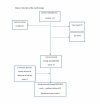Anatomical Variations of the Nasal Cavities and Paranasal Sinuses: A Systematic Review
- PMID: 33614330
- PMCID: PMC7883520
- DOI: 10.7759/cureus.12727
Anatomical Variations of the Nasal Cavities and Paranasal Sinuses: A Systematic Review
Abstract
The anatomy of the nasal cavities and paranasal sinuses is one of the most varied in the human body. The aim of this study is to review the prevalence of anatomical variations in the sinonasal area. This systematic review was conducted according to the Preferred Reporting Items for Systematic Reviews and Meta-Analysis (PRISMA) guidelines. We performed on PubMed a literature search from October 2004 until May 2020. The search strategy included the following keywords: ('paranasal sinus' OR 'frontal sinus' OR 'maxillary sinus' AND ('anatomical variants' OR 'anomalies')). Fifty studies were eligible and included in the analysis. Overall, the studies encompassed a total of 18,118 patients included in this review. Most common anatomical variations include agger nasi cells, nasal septum deviation and concha bullosa. Other variations seen in this region are uncinate process variations, paradoxical middle turbinate, Haller, Onodi and supraorbital ethmoid cells, accessory ostia of maxillary sinus. Less common variations include any sinus aplasia, crista galli pneumatization and dehiscence of the optic or maxillary nerve, internal carotid artery and lamina papyracea. Anatomical variations of this region also differ among ethnic groups. This study highlights the amount, variability and significance of most anatomical variants reported in the literature in the last years. It is essential for the sinus surgeon to have a broad spectrum of knowledge not only of "the typical" anatomy but also all the possible anatomical variations. With modern imaging modalities, anatomical variations can be detected, and uneventful pitfalls might be prevented.
Keywords: anatomical variants; ethnic; paranasal sinus; sinus surgery.
Copyright © 2021, Papadopoulou et al.
Conflict of interest statement
The authors have declared that no competing interests exist.
References
-
- Computed tomography analysis of frontal cell prevalence according to the International Frontal Sinus Anatomy Classification. Choby G, Thamboo A, Won TB, Kim J, Shih LC, Hwang PH. Int Forum Allergy Rhinol. 2018;8:825–830. - PubMed
-
- Frequency, location, and morphology of accessory maxillary sinus ostia: a retrospective study using cone beam computed tomography (CBCT) Hung K, Montalvao C, Yeung AWK, Li G, Bornstein MM. Surg Radiol Anat. 2020;42:219–228. - PubMed
Publication types
LinkOut - more resources
Full Text Sources
Other Literature Sources

